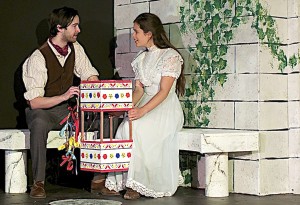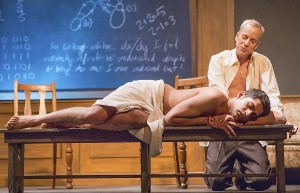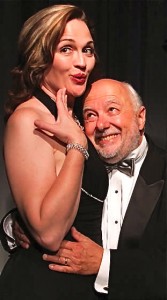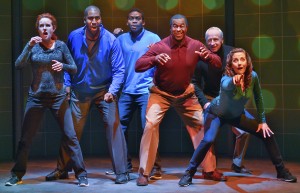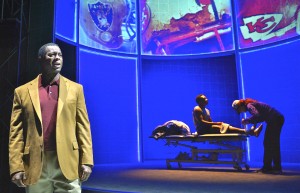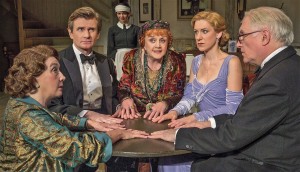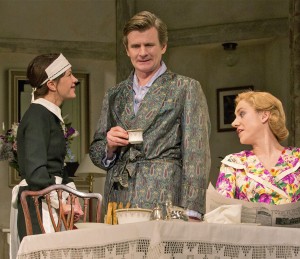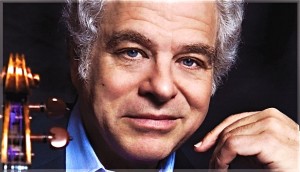[Woody’s [rating: 3]
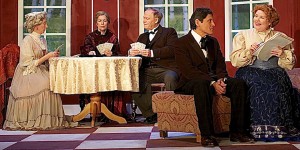
Ensemble cast of “A Month in the Country” includes (left to right) Kim Bromley as Anna, Robyn Wiley as Lizaveta, Mark Shepard as Herr Schaaf, Ben Orega as Michel and Shannon Veon Kase as Natalya. Photo by Robin Jackson.
Sophisticated Natalya, 29, is having a premature midlife crisis.
So she flits between rage and passion.
She ignores the steady, boring love of her husband, Arkady, and the fawning adoration of a friend/wannabe lover, Michel, only to fall for Alexsey, her young son’s naïve 21-year-old tutor.
That’s the heart of “A Month in the Country,” a lightweight comedy of manners weighed down by a touch of the mustiness I should have expected from a play penned in the mid-1800s by Ivan Turgenev, Russian novelist famed for “Fathers and Sons.”
Yet the ensemble cast of Ross Valley Players largely keeps things effervescent and, through its professionalism, overcomes the sluggish pacing the playwright built in.
Not to mention his repetition.
The dozen community theater thespians were good enough, however, to ward off my sporadic desire to snooze.
I admired, too, other elements of the play adapted in 1992 by Irish dramatist Brian Friel (a Tony Award-winner for “Dancing at Lughnasa”):
• Friel’s updated language (“I’m not one of his college sluts”).
• Costume designer Michael A. Berg’s fetching women’s attire (a calculated contrast with his unexciting men’s formal ware).
• The artistic accomplishments of Ken Rowland, who’s created more than 100 extraordinary set designs for the company since 1982 but out-extraordinaried himself with this show’s elegant ebony-and-rose vision of a posh country estate (universal enough to have been located in the Hamptons as easily as Russia).
• Director James Nelson’s brave choice to absent anticipated Russian accents while not limiting actor Ben Ortega’s Hispanic inflections in the role of Michel — and then including comedic German dialect by Mark Shepard as Herr Schaaf (a character with a penchant for malapropisms such as calling himself “a lecher” when he means archer).
Unusual, besides, is the use of offstage actors mouthing interior musings for several characters.
Particularly outstanding performances are turned in by Shannon Veon Kase as Natalya; Wood Lockhart, the veteran workhorse of the RVR troupe as Dr. Shpigelsky, a “bitter, angry peasant” hanger-on who prefers being a matchmaker; and Ortega.
Despite the farcical facets of “A Month in the Country,” Turgenev’s pre-Chekhovian thesis might be summarized by one character declaring “I’m afraid all love is a catastrophe” and another proclaiming “when you find yourself enslaved by love…you’ll know what real suffering is.”
Cynical? Perhaps.
Snarky?
Without doubt.
But great fodder for what advance publicity tells us “A Month in the Country” does — let us laugh at our own foibles (and sometimes misguided appetites).
And yes, the 150-minute period piece is long, as well as long-in-the-tooth.
But that having been said, it’s ultimately as cheery as the recorded bird sounds played before the show starts.
“A Month in the Country” plays at The Barn Theatre, Marin Art & Garden Center, 30 Sir Francis Drake Blvd., Ross, through April 12. Evening performances, Fridays and Saturdays, 8 p.m.; Thursdays, 7:30 p.m. Matinees, Saturdays and Sundays, 2 p.m. Tickets: $14 to $29. Information: (415) 456-9555 or www.rossvalleyplayers.com.
Contact Woody Weingarten at voodee@sbcglobal.net or www.vitalitypress.com



